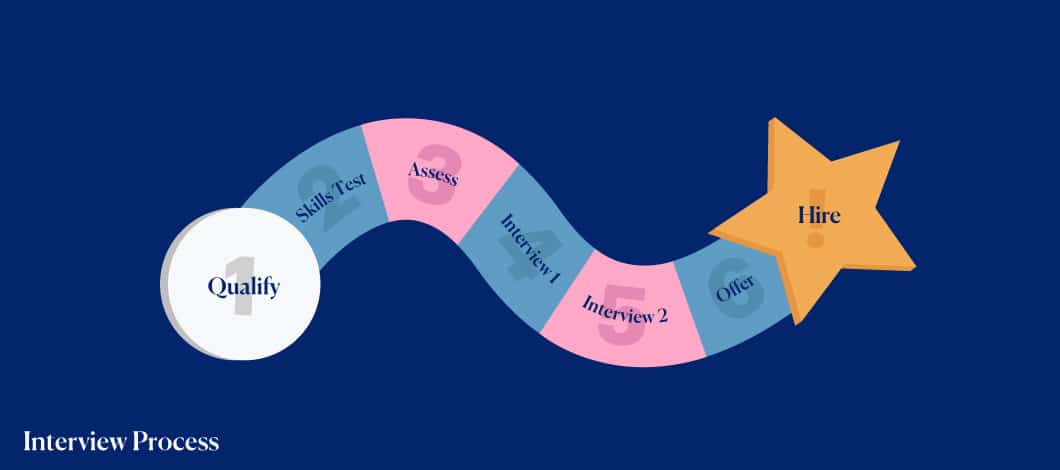With COVID shaking up staffs, knowing how to hire employees can be a critical survival skill. Here’s how to do it right in 10 steps:
Follow our tips on how to implement each of these hiring steps for successful recruitment results.
1. Review Your Hiring Needs
When hiring employees, a preliminary recruitment process step is to review your company’s needs. Consider questions such as:
- Which tasks need to be performed at your company which your current staff is currently not managing at a satisfactory level?
- Can these tasks be added to a current employee’s role or outsourced, or do they require a new employee?
- If any workers have departed or will be departing soon, do they need to be replaced, or could their responsibilities be taken over by a current employee or outsourced?
Asking these types of questions can help you determine whether hiring new employees is really a necessary expense. In some cases, you may be able to bypass the cost and time of the recruitment process by promoting a current employee or by outsourcing.
2. Create an Ideal Candidate Profile
A best practice for hiring top talent is to incorporate your hiring requirements into an ideal candidate profile. This profile should outline the main qualifications you seek in a candidate for a given position, such as:
- Which skills does the position require?
- What educational qualifications are required?
- What experience is required?
- Does the employee need any special licenses or certifications?
As for skills, be sure to include any soft skills the position requires, such as self-motivation, communication or leadership. For remote work positions requiring digital communication tools or other technology, specify which devices or software the candidate should know how to use.

3. Design a Candidate Scoring System
To guide your employee selection, you can create a scoring system to evaluate how well a given candidate matches your ideal candidate profile. To do this, divide the qualifications in your profile into categories and assign a numeric value to each category. You can assign higher values to qualifications which are higher priorities. When reviewing applications and interviews, you can score candidates in each category and add up the totals.
This can help you evaluate candidates more objectively than relying solely on intuitive impressions. It also can save you time sorting through applications by making it easier to identify top candidates. For greater efficiency in reviewing large numbers of candidates, use a digital recruitment-assessment tool with automated scoring features, such as iMocha.
4. Develop an Attractive Compensation Package
To attract top candidates, you need a compelling compensation package. To make your package attractive to your target candidates, do research to find out what workers want and what your competitors are offering.
You can research salary information by using resources such as CareerOneStop’s Salary Finder. Your research should include identifying what type of benefits and perks will appeal to your target candidates. Offering desirable fringe benefits can make you stand out from competing employers.
Building some flexibility into your compensation package may make it easier for you to negotiate with candidates being considered for hire. For example, some qualified candidates who have child-care obligations may be more inclined to accept a job offer if you can accommodate them with flexible work hours or the option of working from home. Consider designing your compensation package in a way that allows you to extend and negotiate options when extending a job offer.
5. Craft an Effective Job Description
Once you’ve defined what you’re looking for and what you’re offering in return, the next step is to create a job description that will attract the type of candidates you’re looking for. Your job description should highlight the top qualifications which you prioritize in candidates, as well as the elements of your compensation package that qualified candidates will find most appealing. To help qualified candidates find your ad online, include relevant keywords that someone might search on when seeking the type of position you offer.
6. Promote Your Job Opening
Once you have a job description, you can begin promoting your job opening. Channels for promoting openings include:
- Internal job boards
- Your company website
- Referrals
- Employment websites such as LinkedIn, Monster and CareerBuilder
- Staffing agencies
- Local newspapers
When using digital recruitment channels, be sure to incorporate relevant target keywords.
7. Screen the Applicants
As applications begin coming in, the next step is to evaluate them and determine which ones to invite to interviews. The most efficient way to do this is to use your scoring system to rank candidates for a match with your ideal candidate profile. You can prioritize candidates with higher scores. Using a digital recruitment tool as suggested above can help speed up the process.
Scores alone don’t tell you everything about a candidate, however. Keep an eye out for candidates who have criteria that make them stand out even if their score isn’t as high as another candidate. For instance, you may notice that a candidate possesses noteworthy work experience on their employment history which makes them worth extra consideration.

8. Standardize Your Interview Process
To process interviews more efficiently, you can standardize your interview process. This involves:
- Standardizing your interview procedures
- Standardizing your interview questions
With respect to standardizing your interview procedures, consider the steps a candidate should go through during the interview process. For example:
- Should they take any pre-interview skill tests, drug tests or other tests?
- Should the interview process involve more than one interviewer?
- Should the interview process involve more than one round of interviews?
With respect to interview questions, develop a standard set of questions to ask each candidate. Open-ended questions that require elaboration to answer will yield more information than questions that can be answered yes or no.
For example, to assess a candidate’s problem-solving ability, you might ask them to recall a time when they overcame a challenge and describe the process they used to overcome it. Online resources such as the Society for Human Resource Management provide suggested job interview questions.
For best results, train your interviewers on how to conduct interviews and ask interview questions. This should include training on what types of illegal interview questions must be avoided to prevent discrimination suits. For instance, you can’t ask a candidate about their age, race or religion.
Interviewers also should be trained to look for nonverbal clues to candidate qualifications. For instance, a candidate’s body language may indicate whether they are attentive to detail. Interviewers can be provided with a scorecard to help guide and record their observations.
9. Set Up Your Onboarding Process
Once you decide to hire a candidate, the next step in the hiring process is to onboard them. An efficient onboarding process can make hiring new employees go smoothly, promoting better worker satisfaction, productivity and retention.
On the other hand, problems with onboarding can impede a new employee’s relationship with your company, or even delay the process long enough that another company hires them away.
You can improve your onboarding process by standardizing your procedures. Steps in the onboarding process can include:
- Introducing employees to supervisors and coworkers
- Assigning mentors to employees
- Completing employee background checks
- Filling out human resources documents to set up payroll and benefits such as health insurance and retirement plans
- Setting up employee digital accounts
- Training employees how to follow routine procedures
To ensure a consistent onboarding experience, use a checklist. Onboarding software can be used to automate the process.
10. Document Your Procedures
After fleshing out the steps you use to recruit new workers, you should document your procedures. This will enable you to create a hiring process checklist you can reference during recruitment. Using a checklist for hiring employees will help ensure that the process goes smoothly and you don’t omit any important steps. Documenting your procedures will make it easier for you to train your recruitment team.
Another advantage of documenting your procedures is that it can help you improve your hiring process. As you implement your procedures, you may notice that some things work well, while others could be improved. For example, you may find that certain interview questions work better than others to elicit desired information. Keep your documentation up-to-date to reflect improvements to your procedures.
Employ Smart Hiring Practices to Optimize Your Workforce
Following these hiring process steps will help you attract, recruit and onboard talented workers who fit your ideal candidate profiles. Using these tips to hire optimal candidates can help you maximize your productivity, reduce employee turnover and ultimately increase your profit margin.
Improving your hiring process may require an investment in employee recruitment agencies or software. If you need financing to cover these costs, consider applying for a business line of credit, working capital loan or other forms of small business financing.










